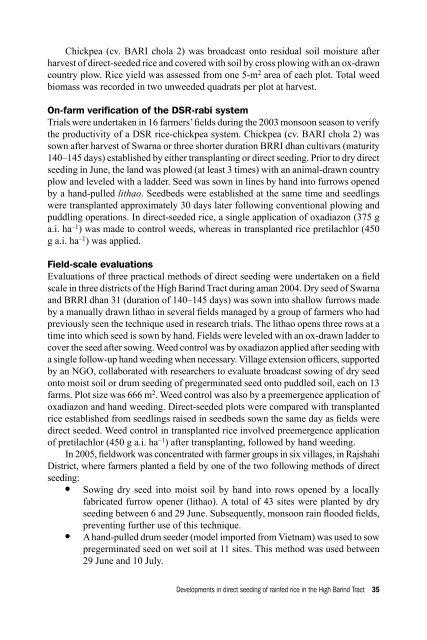Download (2461kB) - University of Greenwich
Download (2461kB) - University of Greenwich
Download (2461kB) - University of Greenwich
- No tags were found...
You also want an ePaper? Increase the reach of your titles
YUMPU automatically turns print PDFs into web optimized ePapers that Google loves.
Chickpea (cv. Bari chola 2) was broadcast onto residual soil moisture afterharvest <strong>of</strong> direct-seeded rice and covered with soil by cross plowing with an ox-drawncountry plow. Rice yield was assessed from one 5-m 2 area <strong>of</strong> each plot. Total weedbiomass was recorded in two unweeded quadrats per plot at harvest.On-farm verification <strong>of</strong> the DSR-rabi systemTrials were undertaken in 16 farmers’ fields during the 2003 monsoon season to verifythe productivity <strong>of</strong> a DSR rice-chickpea system. Chickpea (cv. Bari chola 2) wassown after harvest <strong>of</strong> Swarna or three shorter duration BRRI dhan cultivars (maturity140–145 days) established by either transplanting or direct seeding. Prior to dry directseeding in June, the land was plowed (at least 3 times) with an animal-drawn countryplow and leveled with a ladder. Seed was sown in lines by hand into furrows openedby a hand-pulled lithao. Seedbeds were established at the same time and seedlingswere transplanted approximately 30 days later following conventional plowing andpuddling operations. In direct-seeded rice, a single application <strong>of</strong> oxadiazon (375 ga.i. ha –1 ) was made to control weeds, whereas in transplanted rice pretilachlor (450g a.i. ha –1 ) was applied.Field-scale evaluationsEvaluations <strong>of</strong> three practical methods <strong>of</strong> direct seeding were undertaken on a fieldscale in three districts <strong>of</strong> the High Barind Tract during aman 2004. Dry seed <strong>of</strong> Swarnaand BRRI dhan 31 (duration <strong>of</strong> 140–145 days) was sown into shallow furrows madeby a manually drawn lithao in several fields managed by a group <strong>of</strong> farmers who hadpreviously seen the technique used in research trials. The lithao opens three rows at atime into which seed is sown by hand. Fields were leveled with an ox-drawn ladder tocover the seed after sowing. Weed control was by oxadiazon applied after seeding witha single follow-up hand weeding when necessary. Village extension <strong>of</strong>ficers, supportedby an NGO, collaborated with researchers to evaluate broadcast sowing <strong>of</strong> dry seedonto moist soil or drum seeding <strong>of</strong> pregerminated seed onto puddled soil, each on 13farms. Plot size was 666 m 2 . Weed control was also by a preemergence application <strong>of</strong>oxadiazon and hand weeding. Direct-seeded plots were compared with transplantedrice established from seedlings raised in seedbeds sown the same day as fields weredirect seeded. Weed control in transplanted rice involved preemergence application<strong>of</strong> pretilachlor (450 g a.i. ha –1 ) after transplanting, followed by hand weeding.In 2005, fieldwork was concentrated with farmer groups in six villages, in RajshahiDistrict, where farmers planted a field by one <strong>of</strong> the two following methods <strong>of</strong> directseeding: Sowing dry seed into moist soil by hand into rows opened by a locallyfabricated furrow opener (lithao). A total <strong>of</strong> 43 sites were planted by dryseeding between 6 and 29 June. Subsequently, monsoon rain flooded fields,preventing further use <strong>of</strong> this technique. A hand-pulled drum seeder (model imported from Vietnam) was used to sowpregerminated seed on wet soil at 11 sites. This method was used between29 June and 10 July.Developments in direct seeding <strong>of</strong> rainfed rice in the High Barind Tract 35
















